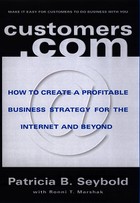Company History
Our Company's DNA:
- Identify technologies that will disrupt an industry.
- Find the pioneers/lead customers who are early adopters and innovators.
- Work closely with these "lead customers" and the emerging players who develop and adapt solutions to meet the needs of these early pioneers.
- Identify customer-critical issues and context that need to be addressed to ensure widespread adoption.
Our "Parent" Company
Seybold Publications and the Seybold Consulting Group started in the early 1970s. Launched by publishing-technology visionary John W. Seybold, who was soon joined by his son, Jonathan W. Seybold. Together, they helped their clients re-invent the publishing industry--moving from hot type to cold type; from analog to digital technology; from typewriters and Linotype machines to video terminals in newsrooms driving phototypesetters. They documented the birth and maturation of the electronic publishing industry in the Seybold Report newsletters.
John Seybold had been a labor arbitrator in the printing industries before launching his own phototypesetting service bureau, Rocappi, in 1961. His approach to assimilating new technologies and pushing the envelope was always to engage ALL of the stakeholders in designing new practices and policies.
Pioneering. In order to solve a tough problem--how to tell a computer how to set type in many different formats and contexts--John Seybold introduced the use of generic mark-up for automating phototypesetting in the 1960's. This approach became codified as SGML (Standard Generalized Mark Up Language), which led to HTML, and spawned the world-wide Web.
Customer Co-Design. In the 1970s, in helping his clients at US News & World Report transition to an editorial newsroom, he and Jonathan spec'd the Atex news publishing system and worked with the company's founders to develop and successfully deploy that system (and many other such systems) in many magazine and newspaper newsrooms around the world.
Educating Entrepreneurs. Jonathan Seybold worked closely with Apple's Steve Jobs in targeting desktop publishing as the "killer app" for the new Macintosh computer. Jonathan and John held Electronic Publishing Seminars around the world to disseminate what they were learning from early adopters of these new technologies. Jonathan Seybold morphed the small seminars into major industry trade shows--Seybold Seminars in the 1970s and 1980s. (Seybold Seminars was sold to Ziff Davis in 1990).
Patricia Seybold apprenticed with her father beginning in 1975, focusing on the spread of electronic typesetting and desktop publishing into the broader business market. She applied the consensus-building form of consulting she learned from her father: including all stakeholders in the planning and decision-making processes when adopting new technologies.
Andrew M. Seybold also joined the family business. Patty Seybold’s specialty area became word processing and office systems. She launched her own monthly newsletter: The Seybold Report on Word Processing in 1976. Andy's specialty was the emerging PC. He was editor-in-chief of The Seybold Report on Professional Computing, which launched in 1980.
Patricia Seybold Group Spin Out: 1985
Patty spun Patricia Seybold’s Office Computing Group out of her father's company in 1985 (it was later renamed the Patricia Seybold Group) . Recognizing the revolutionary potential from distributed systems, object-oriented models and open-source software, she and her team consulted with clients who were early adopters of these technologies. The group hosted popular forums for business executives (Seybold Executive Forums) and technologists (Seybold Technology Forums) in the 1980s and 1990s. Their newsletters included: Patricia Seybold's Office Computing Report, Network Monitor, Unix in the Office, and the Distributed Computing Monitor.
Cross-Organizational Design. in 1989, several clients (Data General, Hewlett-Packard, IBM, Sun, DEC) banded together to form the Object Management Group, which Patty Seybold helped bring to life in order to develop and promulgate distributed object computing.
Customers Co-Design Core PSGroup Offerings: Several of Patricia Seybold Group's clients (Price Waterhouse, Metropolitan Life, Arthur Andersen, etc.) were instrumental in co-designing our Notes on Information Technology (NOIT) service in 1990--the first client-interactive research service published in Lotus Notes, covering groupware, open systems, and distributed computing. .
In 1992, four key clients agreed to be living case studies: American Institute of Physics, Clorox, Mitre Labs, Young & Rubicam. Over a hundred additional clients participated in the first customer co-design workshop designed to redesign these companies' strategies around customer-impacting issues. This week-long workshop was held in Glen Cove, NY. The methodology that emerged and evolved became our core Customer Scenario Mapping methodology.
Shift from IT to Customer Experience. By 1994, The Seybold team had recognized the game-changing potential of the customer revolution that came with the rise of the Internet. In 1994, Patty shifted the company’s focus to consulting and research in customer-impacting technology & business strategies.
Launch of Customers.com. In 1998, Patricia Seybold and Ronni Marshak published the book, Customers.com (through Random House). It quickly sold 40,000 copies and was translated into more than 10 languages. Its premise was revolutionary at the time: the way to win on the Internet is to make it easy for customers to do business with you!
At the same time, the company folded its various monthly electronic newsletters into a single offering: Customers.com Strategic Advisory research service, which is still our current offering. It now comes in two forms: one for technologists and technology entrepreneurs: Customers.com Technologies; and one for business executives: Customers.com Strategies. Both are published weekly.
The Customer Revolution is published in 2001. How to thrive when customers are in control? Measure what matters to customers. This book focused on the role of customer experience in creating brand loyalty. We introduced our customer metrics framework: Quality of Customer Experience (QCE) and a sample dashboard, which we dubbed the Customer Flight Deck.
Outside Innovation is published in 2006. How your customers will co-design your company's future. This book documents many of the ways in which companies have engaged with customers to co-design new products and services.
Customer Scenario Mapping Online Training. In 2008, Patricia Seybold Group first began offering an online training module for its Customer Scenario Mapping customer co-design methodology.



